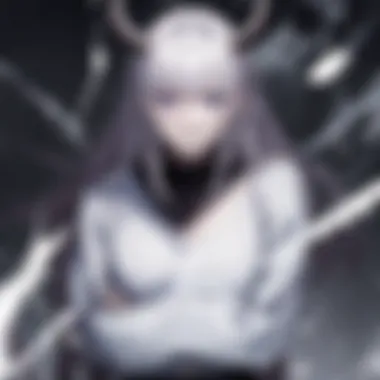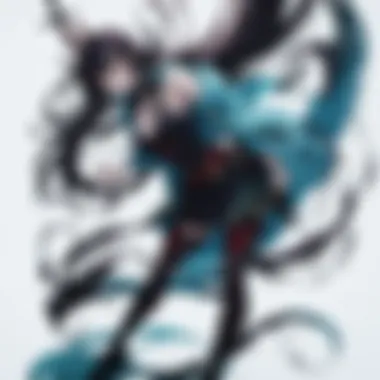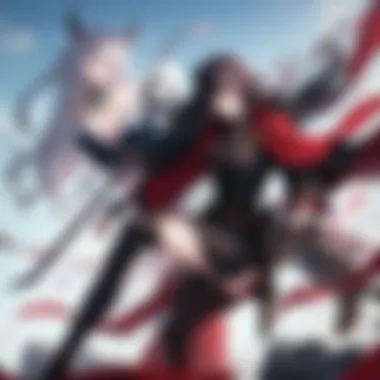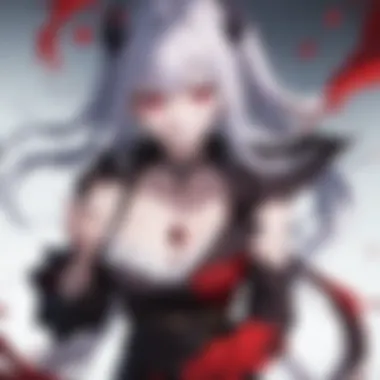Exploring the Depths of Demon Slayer Season Two


Intro
The second season of Demon Slayer dives into darker themes and complex narratives, emphasizing the intricacies of demonic forces. Demons, as adversaries, play a crucial role in the series, impacting character development and the overarching storyline. This season not only explores their origins but also delves into the moral implications that arise from their existence. With an emphasis on the interplay between humanity and demonic entities, viewers are invited to ponder fundamental questions about power, choice, and redemption.
Series Overview
Synopsis and Premise
The narrative resumes following the events in the first season, where Tanjiro Kamado continues his quest to find a cure for his sister Nezuko, who has been turned into a demon. Set in Taisho-era Japan, the story unfolds as Tanjiro and his comrades face more formidable foes. The deeper exploration of demon lore is presented through encounters with various demons, each with distinct backgrounds and motivations. The season not only heightens suspense but enriches the viewer's understanding of the world they inhabit.
Notable Characters
Key characters in this season include:
- Tanjiro Kamado: The determined protagonist on a mission to save his sister.
- Nezuko Kamado: Tanjiro's sister, navigating her dual nature as both human and demon.
- Zenitsu Agatsuma: A fellow demon slayer, whose cowardice often contrasts with his explosive abilities.
- Inosuke Hashibira: Another ally, characterized by his wild nature and fierce combat style.
Each of these characters interacts with demons on multiple levels, allowing for a narrative rich in conflict, growth, and emotional resonance.
Themes and Motifs
Major Themes Explored
Demon Slayer Season Two tackles several significant themes:
- The Nature of Evil: The dichotomy between demons as monsters and their tragic backstories invites reflection on what it means to be evil.
- Family and Sacrifice: The bond between Tanjiro and Nezuko exemplifies familial loyalty amidst the chaos of their world.
- Redemption and Forgiveness: As characters confront their pasts, the possibility of redemption becomes a focal point.
Symbolism in Storytelling
The show employs various symbols to convey deeper meanings. For instance, the demons often reflect the struggles of humanity, their twisted forms symbolizing personal traumas. The themes of light and dark also recur, representing the constant battle between hope and despair.
Artistic Style and Animation
Visual Aesthetics and Design
The visual design in Demon Slayer remains stunning. Each episode employs rich color palettes and detailed backgrounds, immersing viewers in its world. The contrasting designs of demons emphasizes their otherworldly nature while maintaining a connection to human emotions.
Animation Techniques and Trends
The animation techniques in this season are notable for their fluid motion and intricate fight sequences. The Ufotable studio's use of CGI enhances the dynamic action scenes. These trends contribute to the show’s critical acclaim and showcase the animation's evolution within the shonen genre.
"Demon Slayer stands out for its ability to blend traditional animation techniques with modern digital effects, heightening the experience for viewers."
Prelims to Demon Slayer Season Two
Demon Slayer Season Two marks a significant chapter in the narrative, enhancing the framework established in the earlier episodes. This season dives deeper into the intricate universe of demons, presenting a multi-faceted portrayal that goes beyond mere antagonism. Demons are not just obstacles for the protagonists; they embody themes of suffering, humanity, and morality. The exploration of these elements adds depth to the storyline and invites viewers to ponder the darker aspects of the human condition.
Understanding this season is essential for grasping the underlying philosophies of the series. The complexity of character relationships and demon transformations provides insight into the characters' motivations and conflicts. Moreover, this season introduces new demons, each with unique backgrounds and motivations that enrich the narrative.
Exploration of these themes not only captivates the audience but also encourages discussions among fans. Analysis of the demons' roles and their impact on the main characters highlights the show's ability to blend action with emotional resonance. By delving into these topics, the article aims to dissect the layers of meaning within Season Two, paving the way for a more nuanced understanding of Demon Slayer.
Overview of the Series


Demon Slayer, also known as Kimetsu no Yaiba, has garnered global attention for its captivating story and stunning animation. The series follows Tanjiro Kamado, a young boy who becomes a demon slayer to avenge his family and cure his sister, Nezuko, who has been transformed into a demon. The premise deftly intertwines action and emotional stakes, allowing viewers to connect deeply with the characters' journeys.
The animation studio Ufotable has brought a unique aesthetic to the project, utilizing vibrant colors and fluid motion to enhance the storytelling. The combination of strong character arcs, compelling plotlines, and high production quality makes the series stand out in the crowded anime landscape. The second season builds upon this foundation, further immersing viewers in its world and complexities.
Context of Season Two within the Franchise
The context of Season Two is vital for appreciating its narrative expansion. Following the success of the first season and the immensely popular film, Mugen Train, the second season had lofty expectations. It serves as a continuation of Tanjiro's journey while simultaneously exploring the broader implications of his fight against demons.
This season specifically focuses on the Entertainment District Arc, which introduces a darker narrative tone. It emphasizes the struggles between the demon slayers and the formidable Upper Moons. These demons are not only more powerful but also possess rich backstories that invite sympathy and understanding.
This shift in focus enhances the franchise's exploration of themes related to morality and the complexities of good versus evil. As the characters confront their fears and the true nature of their enemies, viewers are encouraged to reflect on these relationships on a deeper level. The careful positioning of Season Two within the overarching narrative illustrates how essential these developments are to the franchise's long-term evolution.
Demons in the Demon Slayer Universe
In the universe of Demon Slayer, demons are not merely hostile entities; they are integral to both the plot and the thematic undertones of the series. Understanding their nuanced representation enhances one’s appreciation of the storytelling. Season Two delves deeper into the existence of demons, their motivations, and the impact they leave on both the characters and the audience. These elements shape the overall narrative arc and illuminate the struggle between good and evil, as well as the flaws in human nature.
Nature of Demons
Demons in the Demon Slayer universe originate from humans who have succumbed to overwhelming despair or malevolence. The transformation into a demon is often marked by a desire for power, immortality, or escape from pain. This foundation establishes demons as tragic figures rather than mere villains. Their existence poses significant philosophical questions regarding humanity, grief, and the consequences of one’s choices.
The physical characteristics of these demons are striking. They possess heightened senses, supernatural abilities, and a variety of forms that reflect their personalities. Some exhibit terrifying appearances, while others may retain a semblance of their former selves. This duality serves to highlight the complexity of the demons' nature. Their humanity can be fleeting, masked by monstrous features and instincts that both terrify and intrigue.
"The demons are a reflection of the inner turmoil that humans often face, which makes them both terrifying and relatable."
Through the lens of demons, the series examines themes of loss, regret, and the drastic measures taken to seek redemption. The emotional backstories of certain demons serve to evoke sympathy and foster a deeper understanding of their motivations. Thus, the nature of demons serves as a vehicle for exploring the darker aspects of humanity, inviting viewers to reflect on their own moral compass.
Demon Hierarchy
The demon hierarchy in Demon Slayer is a critical aspect that shapes various conflicts throughout the series. The structure is defined by power and abilities, with stronger demons exerting dominance over weaker ones. At the top of this hierarchy are the Upper Moons, elite demons who serve directly under Muzan Kibutsuji, the progenitor of all demons. Their strength poses significant threats to demon slayers and is the catalyst for many pivotal battles in Season Two.
Understanding the hierarchy can provide insight into the motivations and rivalries that play out between characters. For instance:
- Muzan Kibutsuji: The central antagonist, whose ambition drives the plot.
- Upper Moons: Powerful figures who command fear and respect, driving the narrative tension.
- Lower Moons: Their role often emphasizes the pressure of competition within the demon realm.
Demons aspire to ascend within this hierarchy, leading to betrayal, alliances, and conflicts among them. This internal struggle mirrors the demon slayers' own challenges, as both sides navigate a world dictated by power dynamics and survival.
The depiction of such a hierarchy enriches the complexity of the anime, illustrating that every demon, irrespective of their actions, operated under a set of circumstances that propelled their development. This adds layers to the storyline, encouraging viewers to engage with the moral ambiguity found in these characters.
Character Analysis: Major Demons in Season Two
The analysis of characters, particularly the demons in Demon Slayer Season Two, is central to understanding the deeper narrative layers of the series. Anime enthusiasts appreciate the complexity of character development, where each demon serves a unique purpose and adds to the story's emotional heft. In this section, we will scrutinize the introduction of new demonic characters, the evolution of already established entities, and the antagonism that drives character development.
Preamble of New Demonic Characters
Season Two introduces several new demons that are pivotal in expanding the story. These characters bring fresh challenges and nuances that push the protagonists to their limits. For instance, Daki and Gyutaro are among the most notable additions.
Daki, a character steeped in elegance yet wrapped in malice, embodies the duality of beauty and horror. Her abilities to manipulate fabric as a deadly weapon showcase a creative approach to combat. Gyutaro, her brother, presents a stark contrast with his brutish exterior. Together, they not only enhance the action but also contribute to the thematic exploration of relational dynamics within the demon world.
This introduction not only brings new adversaries into the narrative but also enriches the existing lore about the demons, highlighting their interconnected narratives and individual backstories.
The Evolution of Existing Characters
The existing demons in Demon Slayer also experience significant evolution in Season Two. Characters like Kibutsuji Muzan, the progenitor of all demons, further reveal their layers through new interactions. Muzan’s manipulative nature is accentuated, showing how his influence corrupts and shapes others.


Additionally, the internal struggles of characters like Tamayo and Yushiro come to the forefront. They represent an alternative to the typical demon narrative. Their relationship with humanity is complex, and their desire for redemption adds depth to their characterization. This evolution invites viewers to consider broader themes of morality and the potential for change, even among demons.
Antagonism and its Role in Character Development
Antagonism plays a pivotal role in character development throughout Season Two. Each demon acts as a foil to the main characters, particularly Tanjiro and Nezuko. The conflicts arise not only from physical battles but also from personal philosophies and emotional struggles.
For example, Daki's and Gyutaro's disdain for humans juxtaposes Tanjiro's compassion and understanding. This conflict emphasizes the core themes of the series, such as the nature of good and evil as well as the struggle for redemption. Tanjiro’s desire to understand his foes is not just a battle tactic; it is a fundamental aspect of his character. Through these layered interactions, viewers are invited into a deeper exploration of what it means to be a demon.
Thematic Exploration of Demons
The thematic exploration of demons in Demon Slayer Season Two is crucial for understanding the show’s broader narrative. The way demons are portrayed goes beyond mere antagonism; they reflect a complex interplay of evil, redemption, and the impact of human emotions. This exploration allows the audience to engage with deeper philosophical questions, challenging the binary views of good and evil.
The Concept of Evil in Demon Slayer
In Demon Slayer, the concept of evil is multifaceted. Demons are not simply malevolent creatures; they embody deeper struggles that resonate with the characters’ own journeys. Each demon often reveals a tragic backstory, emphasizing that evil can stem from trauma and suffering. For instance, the history of the Twelve Kizuki highlights the notion that individuals become demons due to personal tragedies instead of an innate desire to cause harm.
This portrayal raises important questions about morality. Is it possible for someone who commits heinous acts to be worthy of sympathy? The show encourages viewers to reflect on the circumstances that lead to one’s transformation.
Redemption and Transformation Among Demons
Redemption arcs within Demon Slayer add an intriguing layer to the demons' narratives. Some demons display moments of clarity and regret, which suggest that transformation is achievable. This is evident in characters like Akaza, who, despite his violent nature, reveals a yearning for connection.
The series illustrates that redemption is not merely about atoning for past deeds but involves reconciling one’s identity and choices. This theme complicates the audience's understanding of demons, moving them away from one-dimensional villains to entities capable of change, albeit under dire circumstances.
Impact of Human Emotions on Demonic Behavior
The connection between human emotions and demonic behavior is a central theme in the second season. Many demons exhibit traits that stem from their relationships and emotions when they were alive. Grief, love, and rage often guide their actions, showcasing how unresolved feelings can manifest into violent behaviors in their demon forms.
The emotional depth of the characters—both human and demon—creates a rich tapestry of interactions. Viewers witness how the past continues to haunt the demons, influencing their choices even after transformation. This intersection of emotion and action is essential for understanding the motivations behind each character, further cementing the series’ narrative complexity.
"To portray demons as mere villains simplifies the intricate network of emotions and traumas that define them. It’s in their complexities that we find the heart of the story."
The thematic exploration engages the audience in critical thinking about the nature of evil, the possibility of redemption, and the effects of emotions on behavior. This exploration is not just about understanding demons; it leads to reflections on humanity itself.
Narrative Techniques and Demon Portrayal
The portrayal of demons in Demon Slayer Season Two goes beyond mere characterization. It integrates various narrative techniques that heighten the emotional and thematic depth of the story. This section focuses on how these techniques shape the audience's understanding of demonic characters, creating a richer narrative experience. The techniques serve not only to tell a story but also to explore complex themes such as morality, loss, and the nature of evil.
Storytelling Devices Used for Demonic Characters
In crafting demonic figures, the creators of Demon Slayer employ diverse storytelling devices. Flashbacks are one of the primary methods used to provide a backstory for these demons. This technique allows viewers to see the pivotal moments leading to their transformation, which adds layers to their motivations. For instance, the character of Daki provides insight into her painful past, eliciting empathy from the audience despite her malevolence.
Another device is the use of contrast in character design. Demons often have visually striking appearances that juxtapose their horrific actions. This can emphasize the deceptive nature of their beauty, making them more memorable and unsettling. The vibrant art style of Demon Slayer plays a crucial role here, with unique color palettes that set each demon apart while showcasing their individual traits.
Emotional dialogue is also significant in demon portrayal. Conversations between the demons and the main characters reveal underlying conflicts. Those dialogues can show a demon's inner struggle and hint at their desperation for acceptance or redemption. This narrative choice fosters a deeper connection between the audience and the characters, enhancing the emotional stakes of each encounter.
Symbolism Associated with Demons
Symbolism is a powerful tool in Demon Slayer, enriching the narrative associated with demons. Various attributes of these characters carry deeper meanings. For example, the presence of blood marks plays a dual role. It symbolizes not only the demons' cursed existence but also the loss of their humanity. This duality is a recurring theme throughout the season.
The number of eyes on a demon, often several, can represent their insight into human fears and desires. It suggests a heightened perception of the human condition while simultaneously underscoring their detachment. This symbolic detail contributes to the complexity of the demons, depicting them as beings who understand humanity yet are fundamentally alien to it.


"With deep symbolism and intricate storytelling devices, the demons in Demon Slayer invite viewers to reflect on their own humanity and the nature of evil."
The visual motifs of certain demons may also allude to specific cultural folklore. This connection enriches the narrative by grounding fictional elements in real-world mythology, engaging audiences who ardently explore the genre.
By dissecting these elements, one can appreciate how the series moves beyond surface-level conflicts, making it a significant piece of art within the anime landscape.
Critical Reception and Audience Interpretation
Critical reception and audience interpretation of Demon Slayer Season Two play a crucial role in understanding its impact and legacy within the anime community. The way critics evaluate the series can shape public perception and influence potential viewers. Reviews often highlight the strengths and weaknesses of character development, animation quality, and narrative progression. Moreover, audience interpretations provide an additional layer of depth. Fans engage with the material on an emotional level, creating discussions that can even shape future plot directions or adaptations.
The significance lies in the interplay between the creators' intentions and the audience's responses. Critics may note the artistic merits or thematic depth, while fans often relate personally to characters and story arcs. These discussions fuel further interest and investment in the series, making the critical discourse an essential aspect of its culture.
Reviews of Season Two
Reviews of Demon Slayer Season Two have been predominantly positive, emphasizing its high production values and compelling storytelling. Critics have praised the animation quality, which maintains the series' standard of excellence. The art direction, particularly during action sequences, has captivated audiences, showcasing fluid motion that enhances the viewing experience.
Furthermore, character arcs have garnered attention. The introduction of new demons and the evolution of familiar characters enrich the narrative landscape. Critics often highlight how emotional narratives interweave with action, allowing audiences to invest deeply in the characters’ journeys.
- Animation Quality: Exceptional artistry and fluidity during battles.
- Character Development: Deeper exploration of previous characters alongside new ones.
- Thematic Complexity: Layers of meaning that provoke thought and discussion.
Yet, some critiques arise regarding pacing, with specific episodes receiving attention for feeling rushed or uneven. These discussions provide insight into how various elements impact a viewer's emotional connection and overall enjoyment. While there are slight reservations, the consensus remains favorable, encouraging newer audiences to dive into the series.
Fan Theories Regarding Demons
Fan theories surrounding the demons in Season Two of Demon Slayer offer fascinating insights into the community's engagement. Fans often speculate about the origins and futures of both new and existing demonic characters. These theories reflect a deeper understanding of the narrative structure and character motivations.
One prominent theory posits that certain demons hold connections to the series’ main characters. This concept fuels discussions around destiny and how the past intertwines with present battles. Such theories empower fans to explore themes of redemption and loss, which add emotional weight to character arcs.
- Connections to Main Characters: Speculation about lineage and shared experiences.
- Backstories and Redemption Arcs: Analyzing how past choices affect demons' roles.
- Future Plot Developments: Predictions based on established arcs and new revelations.
Fan interpretations do not merely serve as entertainment; they foster a sense of community. Discussions on platforms like Reddit and forums inspire ongoing engagement and investment in the story. As fans share theories, they enrich the narrative, allowing for a multi-faceted view of the demons and their roles in the series.
Overall, critical reception and audience interpretation of Demon Slayer Season Two illustrate its profound impact on viewers and the anime community at large. The conversations spawned by reviews and theories dive deep into the essence of the series, making it a cultural phenomenon in today’s storytelling landscape.
"Art is never finished, only abandoned." — Leonardo da Vinci.
Epilogue
The conclusion of this examination of Demon Slayer Season Two is essential in the context of the entire series. It serves as the final synthesis of the themes discussed throughout this article. The presence of demons is not just a backdrop; they are pivotal in shaping the narrative and the characters’ journeys. In this section, we will highlight the complexity of demons, how they interlink with human emotions, and their broader implications for potential story arcs in future seasons.
Summarizing the Role of Demons in Season Two
In Demon Slayer Season Two, demons represent both conflict and depth. They are not merely antagonistic figures; rather, they embody the tragic backstory of each character. The series does an excellent job of showcasing that being a demon is a product of circumstance rather than sheer evilness. This nuance is evident through main antagonists like Akaza and Daki, who provide a vivid exploration of their motivations.
Key Points:
- Demons provide a contrasting lens through which we understand the protagonists.
- Character arcs often highlight themes of loss, grief, and the search for redemption.
- The hierarchical structure of demons adds an additional layer of complexity, making the battles not just physical but also moral.
By the series' end, it's clear that demons in this season function to elevate the narrative, allowing for a more profound exploration of themes such as humanity, suffering, and motivation. This careful enhancement of character depth through demonic backstories resonates well with audiences, ensuring demons are integral to the storyline rather than mere obstacles to be overcome.
Future Implications for the Series
Considering the ending of Season Two, the implications for future installments are significant. As demons have been painted with shades of gray rather than black and white, the creators have built a framework for further explorations. This direction opens doors for more complex character development and nuanced storytelling.
Future Directions:
- Potential for spin-offs or deeper dives into individual demon backstories.
- Introduction of new characters who challenge the protagonists in unexpected ways.
- Evolving moral dilemmas that push the narrative beyond simple good versus evil.
Overall, understanding the role of demons lays the groundwork for anticipating new themes in subsequent seasons. As the series continues to delve into these topics, it further solidifies its position as a thoughtful and reflective exploration of morality, consequence, and identity in the context of human and non-human struggles.



